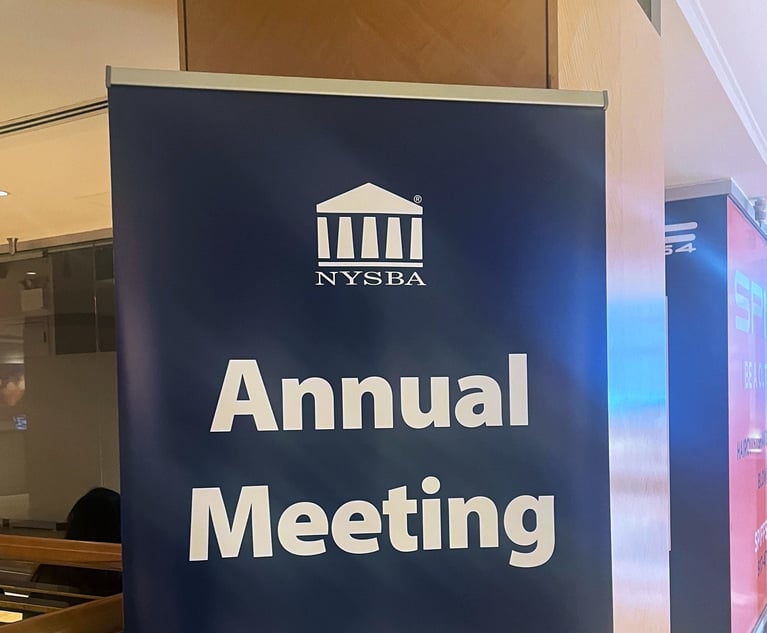NYCLU Report on Upstate Bail System Paints Bleak Picture
Over a five-year period, across eight upstate counties examined, more than 90,000 New Yorkers were held for a day or longer, and more than 45,000 were incarcerated for a week or longer, as they tried to come up with the money for their bail, according to the organization's report.
March 14, 2018 at 10:45 AM
9 minute read

A New York Civil Liberties Union report documenting cases of upstate New Yorkers detained because of unaffordable cash bail paints a stark picture—in raw numbers.
It says that over a five-year period, across eight counties examined, more than 90,000 New Yorkers were held for a day or longer, and more than 45,000 were incarcerated for a week or longer, as they tried to come up with the money for their bail.
Of those people held on bail for any amount of time, 60 percent faced a misdemeanor or violation as their most serious charge, according to the NYCLU.
The report also shows plainly that black New Yorkers accused of a crime and facing cash bail were more likely to spend significant time behind bars than their white counterparts. For example, black detainees were twice as likely as white pretrial detainees to be still be in custody a day after their bail was set.
These were some of the findings from the nine-page report, “Presumed Innocent for a Price,” released Tuesday by the civil rights group. On Wednesday, the NYCLU joins other advocacy groups for a “day of action” in Albany that aims to convince legislators to reform the bail system. More than 300 advocates are expected to descend on the state capital for a rally, a mock bail hearing and meetings with legislators.
Gov. Andrew Cuomo has made the elimination of cash bail for defendants facing misdemeanor and nonviolent felony charges a centerpiece of his criminal justice reform legislative package. Multiple versions of criminal justice reform bills are now shuffling through the legislative process in the state Assembly and Senate, and the next few weeks appear to be crucial.
April 1 is the date by which a state budget should be passed, and bail reform is expected to be part of that legislative package. The governor does have the option of leaving it out of the budget process and then trying to pass a stand-alone bill later, but indications are that it will be included in the budget, Albany observers say.
For the NYCLU, which along with Just Leadership USA, helped organize the “day of action” in Albany, now was the time to release the report, said Nicole Triplett, the group's policy counsel.
“The goal was to shape the legislative negotiations coming up, so that people will be more informed,” she said.
And according to the NYCLU, the report is unique. It provides a first look at numbers and statistics from upstate New York that undergird the alleged mass incarceration created by the use of cash bail, as opposed to the use of alternative, noncash bail options.
Similar statistics from New York City's boroughs have been available for years, said Triplett and her colleague, Michelle Shames, a data and policy analyst, in an interview Tuesday. But the upstate counties had been much harder to pin down and, consequently, the NYCLU report relied on data obtained through public record requests, they said.
Those requests spanned 2010 to 2014 and focused on eight counties—Albany, Dutchess, Monroe, Niagara, Orange, Schenectady, Ulster and Westchester—that were chosen as representative of the 62-county state. The list included small, medium and large counties selected from different corners of the state, Shames noted.
In Albany, one of the most vocal oppositions to bail reform has come from the District Attorneys Association of the State of New York. But it has been certain upstate DAs who have led the opposition. In New York City, Manhattan DA Cyrus Vance Jr. and Brooklyn DA Eric Gonzalez have already announced that their prosecutors will no longer request monetary bail in most low-level or misdemeanor cases. And they've been joined by Westchester County DA Anthony Scarpino Jr. Dutchess County DA William Grady, conversely, has spoken publicly against what he characterized as a formulaic approach.
And so the report, revealing what it calls “a stark glimpse into what New Yorkers have had to endure,” seems directed most pointedly at bail reform opponents.
The reports's numbers appear troubling and, at times, surprising, and it purports to be illuminating a problem that can upend some detainees' lives.
“The harms of unaffordable cash bail are unequivocal: people lose their jobs, homes and families while detained,” and forfeit trial rights in favor of guilty pleas, the report claims. “Yet little has been known about how many people across the state have been locked up because they did not have the means to pay bail, about the charges they faced or how long they were kept in jail.”
Among the findings from the eight counties examined, according to the NYCLU:
- Between 2010 and 2014, 177,390 people were held in custody pretrial. Of those detainees, 113,015 people, or 64 percent, had money bail set.
- The proportion of people who were not able to post bail the day it was set varied widely across counties, ranging from 55 percent of pretrial detainees in Niagara County to 92 percent in Westchester County.
- The proportion of pretrial detainees who remained in custody for seven days or more ranged from just under 20 percent in Orange County to 57 percent in Westchester.
- While black and white New Yorkers each accounted for 45 percent of pretrial detainees who spent time in custody after their bail was set, 48 percent of detainees who spent at least one night in custody were black versus 41 percent white. Meanwhile, 50 percent of those who spent at least a week in custody were black, compared with 38 percent white.
- More than 110,000 people across the eight counties spent time in custody after bail was set. Nearly two-thirds of those bails were $2,500 or less. Half of the bails were $1,000 or less. And one-third of the bails were $500 or less. Yet thousands of people in each county could not pay these amounts readily and be released.
Finally, the report also proposed various reforms to statewide bail practices under a section titled “Recommendations.” They included that people charged with minor offenses be released before trial; that jail time be imposed only when nothing else will ensure a person's return to court; that bail not exceed what someone can afford, that it not be set without lawyers present, and that judges revisit the bail if the amount results in jail time; and that judges be required to consider alternatives to cash bail and to put reasons for bail decisions in writing.
Meanwhile, the statistics from New York City have echoed some of those from upstate. For instance, in fiscal year 2017 nearly 33,000 people were placed in New York City jails because they were not able to post bail, according to a city Comptroller's Office report. Those 33,000 represented about two-thirds of the total 50,000 jail admissions, the report said. More than 50 percent of the 33,000 were black, and one-third of the 33,000 were charged with a misdemeanor, it added. The report also estimated that city detainees lose about $28 million in wages each year as they sit behind bars while struggling to make bail.
The NYCLU's upstate report comes as the group has also brought litigation in the state aimed at curtailing the use of cash bail, which it has argued unfairly targets and impacts the poor. In January, the group announced the filing of an extensive habeas corpus petition, under equal protection and due process principles, on behalf of a Dutchess County resident who had spent months in jail on a petit larceny charge because his $5,000 bail amounted to nearly half of his annual income.
A month later, Dutchess County Supreme Court Justice Maria Rosa ruled that setting cash bail on a defendant, without considering his or her ability to make such a payment, violated the constitutional rights of due process and equal protection. The decision is believed to be the first in state history requiring judges to consider cash bail alternatives and a defendant's ability to pay the bail when setting it.
In turn, DA Grady, in a phone interview with the Law Journal at the time of Rosa's ruling, objected strenuously to it and said his office intended to appeal.
“Although this is an issue that certainly merits further discussion and debate, I do not feel that this judge issuing this decision, which is in effect legislating from the bench, is the appropriate forum to resolve what could very well have statewide implications,” he said.
In January, Grady also publicly opposed reforms to cash bail practices, telling the Law Journal that recent policy shifts away from requesting monetary bail in misdemeanor and violations cases are “somewhat misguided,” and that prosecutors in his county will not be joining their counterparts in some other counties.
“It is somewhat misguided to assume that you can come up with this rule and a list of exceptions to the rule,” he said.
“Each case is different, of course,” he continued, “and there are any number of extenuating circumstances that must justify the court setting the bail that would not be contained in the so-called rule and its list of exceptions.”
He also said, “There are other ways to address the issue, other than an across-the-board mandate that bail cannot be set in all misdemeanor cases.”
Among the alternatives Grady named were pretrial “diversion” programs, such as Dutchess County's Alternatives to Incarceration Program, which he said evaluates alleged offenders who can't make bail for recommended release; electronic monitoring outside of incarceration; and release by the probation department.
This content has been archived. It is available through our partners, LexisNexis® and Bloomberg Law.
To view this content, please continue to their sites.
Not a Lexis Subscriber?
Subscribe Now
Not a Bloomberg Law Subscriber?
Subscribe Now
NOT FOR REPRINT
© 2025 ALM Global, LLC, All Rights Reserved. Request academic re-use from www.copyright.com. All other uses, submit a request to [email protected]. For more information visit Asset & Logo Licensing.
You Might Like
View All
Blake Lively’s Case Highlights How Pre-Litigation Subpoenas Can Expose Harassment in Hollywood
5 minute read


NYSBA Annual Meeting: How In-House Counsel Navigate Gen AI Risk
Trending Stories
Who Got The Work
J. Brugh Lower of Gibbons has entered an appearance for industrial equipment supplier Devco Corporation in a pending trademark infringement lawsuit. The suit, accusing the defendant of selling knock-off Graco products, was filed Dec. 18 in New Jersey District Court by Rivkin Radler on behalf of Graco Inc. and Graco Minnesota. The case, assigned to U.S. District Judge Zahid N. Quraishi, is 3:24-cv-11294, Graco Inc. et al v. Devco Corporation.
Who Got The Work
Rebecca Maller-Stein and Kent A. Yalowitz of Arnold & Porter Kaye Scholer have entered their appearances for Hanaco Venture Capital and its executives, Lior Prosor and David Frankel, in a pending securities lawsuit. The action, filed on Dec. 24 in New York Southern District Court by Zell, Aron & Co. on behalf of Goldeneye Advisors, accuses the defendants of negligently and fraudulently managing the plaintiff's $1 million investment. The case, assigned to U.S. District Judge Vernon S. Broderick, is 1:24-cv-09918, Goldeneye Advisors, LLC v. Hanaco Venture Capital, Ltd. et al.
Who Got The Work
Attorneys from A&O Shearman has stepped in as defense counsel for Toronto-Dominion Bank and other defendants in a pending securities class action. The suit, filed Dec. 11 in New York Southern District Court by Bleichmar Fonti & Auld, accuses the defendants of concealing the bank's 'pervasive' deficiencies in regards to its compliance with the Bank Secrecy Act and the quality of its anti-money laundering controls. The case, assigned to U.S. District Judge Arun Subramanian, is 1:24-cv-09445, Gonzalez v. The Toronto-Dominion Bank et al.
Who Got The Work
Crown Castle International, a Pennsylvania company providing shared communications infrastructure, has turned to Luke D. Wolf of Gordon Rees Scully Mansukhani to fend off a pending breach-of-contract lawsuit. The court action, filed Nov. 25 in Michigan Eastern District Court by Hooper Hathaway PC on behalf of The Town Residences LLC, accuses Crown Castle of failing to transfer approximately $30,000 in utility payments from T-Mobile in breach of a roof-top lease and assignment agreement. The case, assigned to U.S. District Judge Susan K. Declercq, is 2:24-cv-13131, The Town Residences LLC v. T-Mobile US, Inc. et al.
Who Got The Work
Wilfred P. Coronato and Daniel M. Schwartz of McCarter & English have stepped in as defense counsel to Electrolux Home Products Inc. in a pending product liability lawsuit. The court action, filed Nov. 26 in New York Eastern District Court by Poulos Lopiccolo PC and Nagel Rice LLP on behalf of David Stern, alleges that the defendant's refrigerators’ drawers and shelving repeatedly break and fall apart within months after purchase. The case, assigned to U.S. District Judge Joan M. Azrack, is 2:24-cv-08204, Stern v. Electrolux Home Products, Inc.
Featured Firms
Law Offices of Gary Martin Hays & Associates, P.C.
(470) 294-1674
Law Offices of Mark E. Salomone
(857) 444-6468
Smith & Hassler
(713) 739-1250






